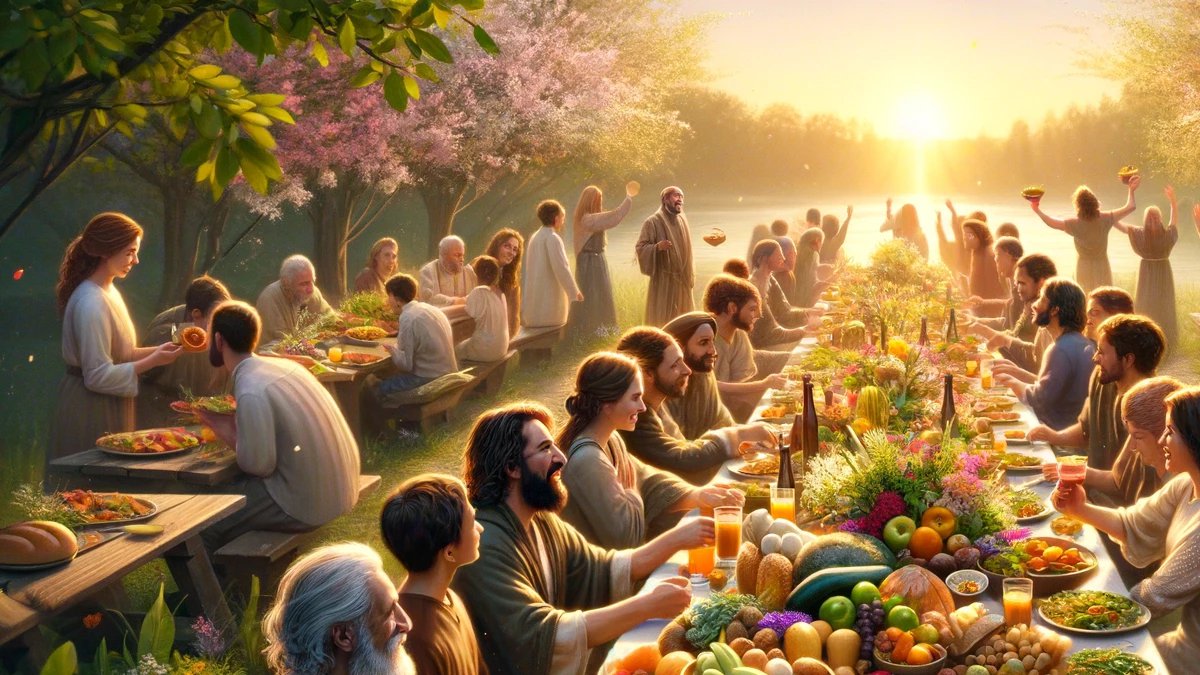Home>Special Themes>What Religion Does Lent Come From


Special Themes
What Religion Does Lent Come From
Published: February 28, 2024
Jason DeRose, Managing Editor at Christian.net, uses his expertise in religion and journalism to deepen understanding of faith's societal impacts. His editorial leadership, coupled with a strong academic background, enriches the platform’s diverse content, earning him recognition in both journalism and religious circles.
Discover the origins of Lent and its significance in various religious traditions. Explore the history and practices of Lent in this special-themed article.
(Many of the links in this article redirect to a specific reviewed product. Your purchase of these products through affiliate links helps to generate commission for Christian.net, at no extra cost. Learn more)
Table of Contents
The Origins of Lent
Lent, a period of fasting, repentance, and spiritual discipline, has its origins in the Christian faith. The word "Lent" itself comes from the Old English word "lencten," which means "spring." The season of Lent is a 40-day period (not including Sundays) that begins on Ash Wednesday and ends on Holy Saturday, the day before Easter Sunday. This period is symbolic of the 40 days that Jesus spent fasting in the wilderness, as described in the Gospels of Matthew, Mark, and Luke. The origins of Lent can be traced back to the early Christian church, where it was established as a time of preparation for new converts to be baptized and for all believers to engage in self-examination and repentance.
-
Biblical Roots: The origins of Lent can be found in the biblical accounts of Jesus' 40-day fast in the wilderness. This period of fasting and temptation is seen as a time of spiritual testing and preparation for his public ministry. The early Christians, recognizing the significance of this period, began to observe a 40-day fast as a way of imitating Jesus' experience and preparing themselves for the celebration of Easter.
-
Early Church Practices: The early church fathers, such as Irenaeus and Tertullian, wrote about the practice of fasting before Easter as a time of spiritual discipline and self-examination. Over time, the length and practices of Lent evolved, with the Council of Nicaea in 325 AD formalizing the 40-day period of fasting and penance.
-
Development of Lenten Observances: As Christianity spread and diversified, different traditions and practices surrounding Lent emerged. The Western Church, particularly the Roman Catholic Church, emphasized the themes of repentance, fasting, and abstinence during Lent. In contrast, the Eastern Orthodox Church focused on a period of spiritual renewal, prayer, and almsgiving. Despite these variations, the underlying purpose of Lent remained consistent across different Christian traditions.
The origins of Lent are deeply rooted in the historical and spiritual development of the Christian faith. This period serves as a time of reflection, repentance, and preparation for the celebration of Easter, making it a significant and meaningful observance for Christians around the world.
Read more: What Religions Fast During Lent
The History of Lent in Christianity
-
Early Christian Practices: In the early centuries of Christianity, the observance of Lent varied among different Christian communities. While the duration and specific practices differed, the common thread was the emphasis on preparation and penitence leading up to Easter. The early Christians viewed Lent as a period of spiritual discipline, marked by fasting, prayer, and almsgiving. This focus on self-examination and repentance was seen as essential for spiritual growth and renewal.
-
Council of Nicaea: The formalization of Lent as a 40-day period can be traced back to the Council of Nicaea in 325 AD. This significant gathering of Christian bishops established the date of Easter and standardized the observance of Lent across the Christian world. The 40-day duration was chosen to mirror the 40 days that Jesus spent fasting in the wilderness, as described in the Gospels. The Council's decision solidified the importance of Lent as a time of preparation and spiritual reflection for all believers.
-
Medieval Developments: During the medieval period, Lent became more structured and regulated within the Western Church. The practice of abstaining from certain foods, particularly meat, and engaging in acts of penance became more formalized. The Lenten season was marked by a sense of solemnity and introspection, with the faithful being called to focus on prayer, repentance, and acts of charity. The observance of Lent became deeply ingrained in the liturgical calendar of the Church, shaping the religious and cultural practices of the medieval Christian world.
-
Reformation and Beyond: The Protestant Reformation brought about changes in the observance of Lent within various Christian denominations. While some Protestant groups chose to downplay or modify the traditional Lenten practices, others continued to uphold the significance of Lent as a period of spiritual preparation. The diversity of approaches to Lent within Christianity reflects the complex historical and theological developments that have shaped the religious landscape over the centuries.
-
Contemporary Practices: In the present day, the observance of Lent continues to hold a central place in the liturgical calendar of many Christian traditions. The 40-day period remains a time of spiritual reflection, self-denial, and preparation for the celebration of Easter. While the specific practices and customs associated with Lent may vary among different denominations, the underlying purpose of drawing closer to God through prayer, fasting, and acts of mercy remains a common theme across the diverse tapestry of Christianity.
The history of Lent in Christianity is a testament to the enduring significance of this season as a time of spiritual renewal and preparation. From its early beginnings in the early Christian church to its diverse expressions in contemporary Christian worship, Lent continues to be a meaningful and transformative period for believers worldwide.
The Role of Lent in Different Religious Traditions
-
Roman Catholicism: In Roman Catholicism, Lent holds a central place in the liturgical calendar. It is a time of fasting, abstinence, and penitential practices, with a focus on self-examination and spiritual discipline. The faithful are called to observe Ash Wednesday as the beginning of Lent and to participate in the sacrament of reconciliation. The Lenten season is marked by the abstention from meat on Fridays and the practice of giving up a particular indulgence or habit as a form of self-denial. The culmination of Lent is the observance of Holy Week, which includes the commemoration of Jesus' passion, death, and resurrection.
-
Eastern Orthodoxy: In the Eastern Orthodox tradition, Lent, known as the Great Lent, is a period of intense spiritual preparation for the celebration of Easter. The emphasis is on prayer, fasting, and almsgiving as a means of drawing closer to God. The faithful adhere to a strict fasting regimen, abstaining from meat, dairy, and other animal products throughout the entirety of Lent. The Lenten services and liturgical hymns reflect the somber and reflective nature of this season, leading up to the joyous celebration of Christ's resurrection on Easter Sunday.
-
Protestantism: Within Protestant denominations, the observance of Lent varies widely. Some Protestant churches, particularly those within the liturgical tradition, such as Anglican and Lutheran churches, observe Lent with a focus on repentance, prayer, and self-examination. The Lenten season is seen as an opportunity for spiritual growth and renewal, often accompanied by special worship services and study groups. Other Protestant traditions, however, may downplay the significance of Lent or choose to focus on different forms of spiritual preparation leading up to Easter.
-
Orthodox Christianity: In the Orthodox Christian tradition, Lent is a period of rigorous fasting and prayer, with a strong emphasis on repentance and spiritual discipline. The faithful adhere to a strict fasting regimen, abstaining from meat, dairy, fish, and oil for the duration of Lent. The Lenten services are marked by a sense of solemnity and introspection, as the faithful engage in acts of charity and self-denial. The observance of Lent culminates in the celebration of Pascha, the Orthodox Easter, which is preceded by the solemn services of Holy Week.
-
Other Christian Traditions: In addition to the major Christian denominations, various other Christian traditions and communities observe Lent in unique ways. For example, the Coptic Orthodox Church, the Ethiopian Orthodox Tewahedo Church, and the Armenian Apostolic Church all have distinct customs and practices associated with the Lenten season. These traditions often reflect the cultural and historical contexts in which they developed, adding richness and diversity to the tapestry of Christian observance.
The role of Lent in different religious traditions reflects the diverse ways in which believers seek to prepare themselves spiritually for the celebration of Easter. While the specific practices and customs may vary, the underlying themes of repentance, prayer, and self-denial remain central across the spectrum of Christian faith traditions.
The Symbolism of Lent in Various Faiths
-
Roman Catholicism: In Roman Catholicism, Lent symbolizes the 40 days that Jesus spent fasting in the wilderness, enduring temptation and preparing for his ministry. The ashes used on Ash Wednesday, the beginning of Lent, symbolize repentance and mortality, reminding believers of their need for God's mercy. The practice of fasting and abstinence during Lent serves as a reminder of Jesus' sacrifice and the call to self-discipline and spiritual renewal.
-
Eastern Orthodoxy: Within the Eastern Orthodox tradition, the symbolism of Lent is deeply rooted in the themes of repentance, purification, and spiritual warfare. The rigorous fasting regimen and the solemn liturgical services reflect the journey of the faithful towards spiritual transformation. The Lenten period is seen as a time of spiritual combat against sin and a preparation for the victory of Christ over death and sin in the celebration of Easter.
-
Protestantism: In Protestant denominations, the symbolism of Lent often centers on the themes of self-examination, renewal, and preparation for the joy of Easter. The Lenten season serves as a time for believers to reflect on their relationship with God, to seek forgiveness, and to recommit themselves to a life of faith and discipleship. The emphasis on prayer, study, and acts of mercy during Lent reflects the call to deepen one's spiritual journey and to align with the redemptive work of Christ.
-
Orthodox Christianity: Within Orthodox Christian tradition, the symbolism of Lent is intricately connected to the journey of salvation and the restoration of humanity's communion with God. The strict fasting discipline and the solemn liturgical services symbolize the struggle against the passions and the pursuit of holiness. The Lenten journey culminates in the celebration of Pascha, signifying the triumph of life over death and the renewal of all creation through Christ's resurrection.
-
Other Christian Traditions: Various other Christian traditions, such as the Coptic Orthodox Church, the Ethiopian Orthodox Tewahedo Church, and the Armenian Apostolic Church, imbue Lent with unique symbolism and practices. These may include cultural expressions of repentance, fasting, and communal solidarity, reflecting the diverse ways in which believers seek to embody the spiritual significance of Lent within their specific cultural and historical contexts.
The symbolism of Lent in various faiths underscores the universal themes of repentance, renewal, and spiritual preparation for the celebration of Easter. While the specific expressions may vary, the overarching message of Lent as a time of introspection, discipline, and anticipation of the redemptive work of Christ remains a unifying aspect across diverse Christian traditions.
The Practices and Observances of Lent in Different Cultures
-
Latin America: In many Latin American countries, Lent is observed with a rich tapestry of cultural and religious traditions. One of the most notable customs is the celebration of Carnaval, a festive period of indulgence and revelry that precedes the solemnity of Lent. This vibrant celebration, characterized by colorful parades, music, and dance, serves as a prelude to the introspective season of Lent. During Lent, Latin American communities engage in various observances, including the reenactment of the Stations of the Cross, processions, and the creation of intricate sawdust carpets for Holy Week. The culinary traditions of Lent in Latin America also reflect a blend of indigenous and European influences, with dishes such as seafood stews, meatless tamales, and sweet breads symbolizing the spirit of abstinence and solidarity.
-
Philippines: In the Philippines, Lent is marked by deeply rooted religious practices that blend indigenous customs with Spanish colonial influences. The observance of Lent begins with Ash Wednesday, where the faithful receive ashes on their foreheads as a sign of repentance and mortality. Throughout the Lenten season, Filipinos participate in the Pabasa, a continuous chanting of the Passion of Christ, and the Visita Iglesia, a tradition of visiting seven churches to pray and meditate. The pinnacle of Lent in the Philippines is the observance of Holy Week, which includes dramatic reenactments of the Passion, crucifixion processions, and the unique tradition of the Senakulo, a theatrical portrayal of the events leading to Christ's death. The Filipino culinary heritage also plays a significant role during Lent, with meatless dishes such as vegetable stews, fish-based delicacies, and sweet rice cakes being prepared and shared within communities.
-
Greece: In Greece, the observance of Lent, known as Sarakosti, is characterized by a blend of religious customs and culinary traditions. The faithful engage in a period of fasting and abstinence, refraining from meat, dairy, and oil throughout the 40-day Lenten period. The Greek Orthodox Church holds special services and liturgical rites, including the reading of the Great Canon of St. Andrew and the Akathist Hymn. The culinary customs of Lent in Greece are reflected in a rich array of fasting dishes, such as lagana bread, a flatbread traditionally consumed on Clean Monday, the first day of Lent. Other Lenten delicacies include seafood, legumes, and a variety of vegetable-based dishes, all prepared with an emphasis on simplicity and restraint.
-
Ethiopia: In the Ethiopian Orthodox Tewahedo Church, the observance of Lent, known as Abiy Tsom, holds a central place in the religious and cultural life of the faithful. The Lenten period is marked by rigorous fasting, with the consumption of animal products and the intake of food and drink restricted during specific days. The faithful engage in daily prayers, scripture readings, and acts of charity, seeking spiritual purification and renewal. The observance of Lent culminates in the celebration of Easter, known as Fasika, which is heralded with joyful liturgical services and communal feasting. The Ethiopian culinary traditions during Lent feature a rich array of fasting dishes, including lentil stews, spicy vegetable curries, and injera, a traditional sourdough flatbread, all prepared in accordance with the fasting guidelines of the church.
-
India: In the state of Kerala, India, the Christian community observes Lent with a blend of religious devotion and cultural customs. The faithful engage in prayer services, scripture readings, and acts of charity, seeking spiritual growth and reflection during the Lenten season. The observance of Lent is also intertwined with the rich culinary heritage of Kerala, with traditional fasting dishes such as vegetable curries, rice-based delicacies, and savory snacks being prepared and shared within families and communities. The Lenten period in Kerala is also marked by the tradition of the Way of the Cross, a symbolic reenactment of Jesus' journey to Calvary, and the observance of Maundy Thursday, commemorating the Last Supper.
The practices and observances of Lent in different cultures reflect the diverse ways in which believers around the world engage in spiritual reflection, self-discipline, and preparation for the celebration of Easter. These cultural expressions of Lent add depth and richness to the universal themes of repentance, renewal, and anticipation of the redemptive work of Christ.















